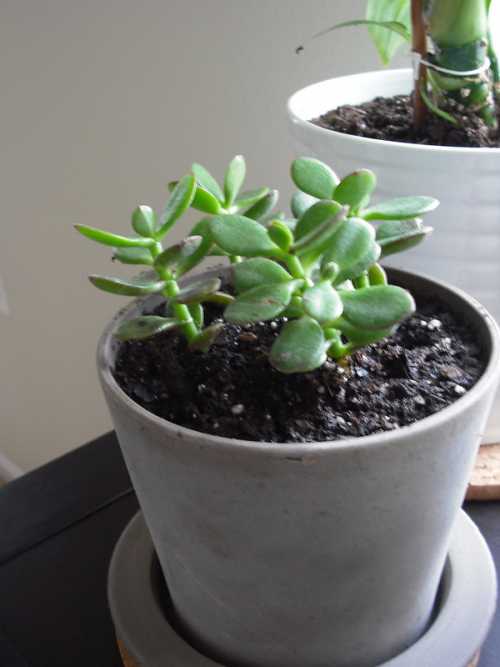The jade plant is a lovely plant that is commonly seen as an interior house plant. It is indigenous to Southern African areas. The Jade plant is often known as the money plant. It encourages the growth of lovely yellow and green leaves. It may be grown and transplanted in both small and big pots. Despite its beauty, the jade plant draws a wide variety of pests. In an effort to keep the attractiveness of your Jade plant, one should keep bugs away from it.
If you’re not sure how your jade plant is acting strangely, it might be due to insect invasion. However, what pests damage the jade plant, or how do we get rid of them? Let us investigate!
How to Get Rid of Bugs on Jade Plants?

Bugs that commonly attack jade plants include:
- Spider mites
- Gnats
- Mealybugs
- Aphids
- Scales
Ways to get rid of them –
Step 1 – Make use of Rubbing Alcohol
If you detect little scale insects (typically small & brown), take any rubbing alcohol then wipe it on the leaf surface. If the bugs are crawling up many branches, fill a spray container with alcohol to spray their leaves. Bring the plant outdoors with a napkin or a brush. Swipe or brush the insects that are clinging to the plant. Take back the plant into the house.
Also Read: Why Peace Lily Flower Turning Yellow, Brown or Black?
Step 2 – Cold, and moist exterior weather should be avoided.
Place your Jade plant in a sunny location to avoid moths and mealy bugs. The heat of the site helps warm the ground, reducing the wet conditions required for these sorts of pests to collect and survive off your Jade Plant. A Jade plant typically requires 4 hours of direct sunshine every day, and more if feasible. They do best in the early morning or late afternoon sunshine. Keep your Jade plant away from the hottest part of the day. Give immature Jade plants as little bright sun as possible.
Step 3 – Watering
Keep an eye on how much watering you give the Jade plant. The ground should constantly be on the dry end or just slightly wet. Excessive moisture encourages the growth of mosses and mealy bugs. Overwatering the Jade plant may result in root damage Mold, as well as mealy bugs, can collect on the roots. Jade plants require just occasional irrigation. To correctly calculate the Jade plant’s water requirements, check the soil using a moisture testing tool.
Step 4 – Make use of a gentle soapy liquid solution.
Soapy water may help to keep dust mites as well as spider mites at bay. Fill the base of a spray bottle halfway with soap. Stir the spraying container after filling it with lukewarm water. Spray on the leaves. But don’t over soak the greens and harm them. The leaves must have a little sheen or gleam from the washing water. Do over a couple of months, or sometimes often if dust mites and spider mites are found. Use normal dish soap with this process.
Also Read: How Much Sunlight Does Peace Lily Need?
What are Mealybugs?
The mealybug is by far the most frequent bug of jade plants. Mealybugs produce white, cottony spots at the connections where leaves connect to stems. Its mouthparts penetrate plant tissues, allowing them to feast on living plants. Mealybugs produce a sticky fluid called honeydew while they eat. Its sticky honeydew is a perfect habitat for the germs of the fungus-sooty mold. Not just can mealybug infestations cause sap depletion in jade plants, but they also frequently result in a sooty fungus infestation.
Mealybugs as well as other jade plant insects are hard to eliminate since jade plants are hyper delicate to horticultural cleaners and lubricants. These pesticides might be excessively strong on the delicate leaves, causing further damage. Rather, mealybugs on jade plants should be removed using rubbing alcohol-soaked cotton swabs or Q-tips. Mealybugs, soft scale, or spider mites all are tiny insects that go undetected for long periods and therefore can readily hide in difficult-to-reach plant surfaces.
Recognition:
- The plant’s fluffy cotton
- Oval in form
- Sucking sap from the plant
- Brown or cream in color
- Undeveloped ones have a waxy texture.
- Mealybug males have wings.
Signs:
- Leaf development that is deformed
- Growth has been slowed.
- The yellow leaves
- Leaf decline
- discovered on the underside of the leaves or cuttings
Also Read: How to Revive a Dying Pothos Plant?
How to get rid of mealybugs on jade plants?
Rubbing alcohol is inexpensive and widely available; some people prefer MaxTite Isopropyl Alcohol 70 percent since it is both inexpensive and effective. You may also discover that utilizing a spray bottle helps make the procedure much simpler.
Now take the rubbing alcohol and just spritz this on the jade plant. Please ensure you sneak into all difficult spots since that’s where mealybugs generally congregate. If you discover the infection soon enough, 1 course of treatment will suffice. Otherwise, many mealybugs will emerge in 2-3 days and at that point, you should spray your plant once.
Follow this method every several days till the mealybugs vanish! The good news is that rubbing alcohol is secure for plants and will not harm the houseplant.
Why do pests infest jade plants?
If bugs inhabit your jade plant, we must take the appropriate actions to eradicate them lest they control over and destroy them.
Overwatering
Most problems with jade plants are caused by overwatering. Jade plants cannot withstand overwatering since they dislike being damp and would react negatively in such situations. It can happen if you overwater your jade plant or even if you irrigate it without monitoring the humidity content in the soil.
Excessive moisture will arise when the pot’s draining arrangement is inadequate. Even though you water the plants properly, they will struggle if there is no appropriate drainage. The ground and base of your jade plant never breathe when it is left in wet soil for an extended length of time. As a result, the humid condition in the ground and roots can result in root rotting situations.
This contributes to insect outbreaks by providing an ideal habitat for insects to exploit and germs and fungus to thrive. If the gardener doesn’t really recognize and resolve the issue early on, there is a good risk that the plant may die. The things you need to do are as follows:
- Make sure your pot has adequate drainage.
- Make use of well-drained garden soil.
- Feed the plant whenever the soil becomes dry.
- Put the plant in a well-lit area that receives at least six hours of clear indirect sunlight every day.
Also Read: Overwatered Peace Lily: Signs & How to Revive Peace Lily
Excessive humidity
Jade plants don’t really like excessive humidity because when grown in excessive humidity environments, they are more prone to root rot as well as insect problems. Excessive humidity can develop naturally as a result of weather conditions. Should you reside near water, your house may well have a high moisture content. High moisture content can also be caused by watering jade plants.
If you overwater your jade plant, then the humidity level may increase. Since the water evaporates from the surface of the ground, the moisture content surrounding your plants rises.
Insects have a special ability for detecting high moisture regions; they require a wet environment to thrive, else their small bodies would dry over and perish. That’s why, should your jade plant live in these kinds of circumstances, it may invite pests.
Inadequate air circulation
Jade plants thrive in areas with good ventilation. It contributes to the reduction of humidity. Plants also prefer oxygenated soil mixes that allow water and air to circulate freely throughout. The water would rapidly dry up, reducing the likelihood of fungal development and insect assault. But, if this situation remains, germs will flourish and proliferate rapidly.
Conclusion
A mealybug or other bug infection is unpleasant, and therefore no plant owner or passionate gardener likes to struggle with any of it. The easiest approach to prevent mites is to inspect your houseplants on a routine basis and search for patterns or tiny bugs. With some of these instructions, you get access to all potential cures and also information on how to get clear of mealybugs and other pests.
